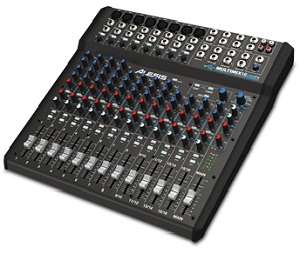Alesis MultiMix 16 USB: smaller, more versatile, energy-efficient
(ShackMan | Posted 2011-01-18)

Often when companies start making units that pull double and triple duty and start touting energy efficiency, quality suffers somewhere. This is not the case, however, with Alesis' new mixer, the MultiMix 16 USB FX. It's a 16-channel mixer (if you didn't guess after reading the title) that's more compact, more energy-efficient, and more versatile than it's predecessors in several ways.
First it uses 36% less energy than Alesis' previous models for reliability and efficiency. Second, it features an improved signal-to-noise ratio for decreased grain and white noise in the audio. Third, it's smaller than previous models, and it gets even smaller. The wings are removable for fitting into really tight spaces where inches matter. Finally, it features a USB input/output, with which users can record to their computer and enjoy a bidirectional stereo signal. That means that users can use their computer speakers as monitors or route audio from their computer through the mixer and into headphones or another monitoring device. All this can be done wihout ever installing drivers, whether you use a Mac or a PC.
The MultiMix comes complete with the standard features as well. Eight XLR inputs each find independent gain faders and switchable phantom power to accommodate all different kinds of microphones. 1/4" line inputs are also available on all 16 channels. A high-impedance input on channel two enables direct connection of a guitar or bass – a great convenience for singer/songwriters looking to get a clean, "hot" signal. A Tape RCA stereo input is also included adding the ability to mix in audio from other sources such as a CD or LP player.
Each channel has its own multi-band EQ, and channels 1 through 4 feature sweepable, parametric midrange control voiced specifically for tailoring the sound of microphones used (whether for voice or mixing a drumset). There's also an effects section for adding in Delay, Reverb, or Phaser. This is controlled on each channel by the pre- or post-EQ fader knobs. The mixer also contains auxiliary outputs as well as insert jacks on channels one through four to allow audio to be processed by external effect units.
James Rushin is a bassist, keyboardist, writer, and composer living and working in the Greater Pittsburgh area. He has performed with Selmer artist Tim Price, Curtis Johnson, guitarists Ken Karsh and Joe Negri. His compositions have been featured at West Virginia University and Valley Forge Christian College. He will be spending the Fall and Winter months working on playwright Frank Gagliano's Voodoo Trilogy and Bodoni County Songbook.
Got questions? Comments? James can be reached as ShackMan in the Music Gear Review forums, or you may e-mail him at James.Rushin@MusicGearReview.com.



